Related Research Articles
Jedi, Jedi Knights, or collectively the Jedi Order are fictional characters, and often protagonists, featured in many works within the Star Wars franchise. Working symbiotically alongside the Old Galactic Republic, the Jedi Order is depicted as a religious, academic, meritocratic, and military (peacekeeping) organization whose origin dates back thousands of years before the events of the first film released in the franchise. The fictional organization has inspired a real-world new religious movement and parody religion: Jediism.

Luke Skywalker is a fictional character and the protagonist of the original film trilogy of the Star Wars franchise created by George Lucas. Portrayed by Mark Hamill, Luke first appeared in Star Wars (1977), and he returned in The Empire Strikes Back (1980) and Return of the Jedi (1983). Over three decades later, Hamill returned as Luke in the Star Wars sequel trilogy, with a cameo in The Force Awakens (2015) before playing a major role in The Last Jedi (2017) and The Rise of Skywalker (2019). He later played a digitally de-aged version of the character in the Disney+ series The Mandalorian, appearing in the second-season finale, which premiered in 2020, and The Book of Boba Fett, in the sixth episode, released in 2022.
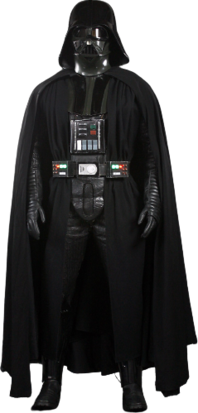
Darth Vader is a character in the Star Wars franchise. He is the primary antagonist of the original film trilogy and, as Anakin Skywalker, is the protagonist of the prequel trilogy. Star Wars creator George Lucas has collectively referred to the first six episodic films of the franchise as "the tragedy of Darth Vader". He has become one of the most iconic villains in popular culture, and his mask is considered one of the most iconic character costume designs of all time.

Star Wars: Episode III – Revenge of the Sith is a 2005 American epic space opera film that is the sequel to The Phantom Menace (1999) and Attack of the Clones (2002). It is the sixth film in the Star Wars film series, the third installment in the Star Wars prequel trilogy, and third chronological chapter of the "Skywalker Saga". It is written and directed by George Lucas, who also served as executive producer. The film stars Ewan McGregor, Natalie Portman, Hayden Christensen, Ian McDiarmid, Samuel L. Jackson, Christopher Lee, Anthony Daniels, Kenny Baker, and Frank Oz.
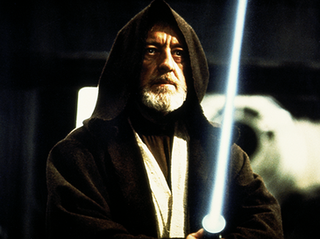
Obi-Wan Kenobi is a fictional character in the Star Wars franchise. Within the original trilogy, Obi-Wan is a Jedi Master as a supporting character and is portrayed by English actor Alec Guinness. In the later-released prequel trilogy, a younger version of the character serves as one of the two main protagonists, alongside Anakin Skywalker, and is portrayed by Scottish actor Ewan McGregor. In the original trilogy he is introduced as Ben Kenobi, an alias he uses while in hiding from the Empire. He is a mentor to Luke Skywalker, to whom he introduces the ways of the Jedi. After sacrificing himself in a duel against Darth Vader, Obi-Wan guides Luke through the Force in his fight against the Galactic Empire. In the prequel trilogy, set two decades earlier, he is initially a Padawan (apprentice) to Jedi Master Qui-Gon Jinn, and later mentor and friend of Luke's father Anakin, who falls to the dark side of the Force and becomes Vader. The character briefly appears in the sequel trilogy as a disembodied voice, speaking to protagonist Rey, and serving as the namesake of Ben Solo. He is frequently featured as a main character in various other Star Wars media, including the streaming television miniseries Obi-Wan Kenobi, in which McGregor reprised the role.

Count Dooku of Serenno, also known by his Sith name Darth Tyranus, is a fictional character in the Star Wars franchise, created by George Lucas. He is an antagonist in the Star Wars prequel trilogy, appearing in both Episode II – Attack of the Clones (2002) and Episode III – Revenge of the Sith (2005), played by Christopher Lee, as well as associated media, such as books, comics, video games, and television series. Actor Corey Burton has voiced Dooku in most of his animated and video game appearances, most notably Star Wars: Clone Wars (2003–2005), Star Wars: The Clone Wars, and the miniseries Tales of the Jedi (2022). Lee reprised the role in the 2008 animated film that launched The Clone Wars series.
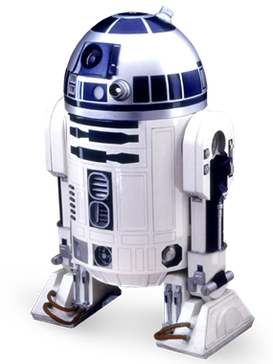
R2-D2 or Artoo-Detoo is a fictional robot character in the Star Wars franchise created by George Lucas. He has appeared in ten of the eleven theatrical Star Wars films to date, including every movie in the original trilogy, prequel trilogy, and sequel trilogy. At various points throughout the course of the films, R2, an astromech droid, is a friend to C-3PO, Padmé Amidala, Anakin Skywalker, Leia Organa, Luke Skywalker, and Obi-Wan Kenobi. R2-D2 and his companion C-3PO are the only characters to appear in every theatrical Star Wars film, with the exception of Solo: A Star Wars Story (2018).

Yoda is a fictional character in the Star Wars universe, first appearing in the 1980 film The Empire Strikes Back. He is a small, green humanoid alien who is powerful with The Force and is a leading member of the Jedi Order until its near annihilation. In The Empire Strikes Back, Yoda was voiced and puppeteered by Frank Oz, who reprised the role in Return of the Jedi, the prequel trilogy, and the sequel trilogy. Outside of the films, the character was mainly voiced by Tom Kane, starting with the 2003 Clone Wars animated television series until his retirement from voice acting in 2021. Yoda is an iconic figure in popular culture due to his distinct pattern of speech and role as a wise mentor.

The Skywalker family is a fictional legendary human family in the Star Wars franchise. Within the series' fictional universe, the Skywalkers are presented as a bloodline with strong inherent capabilities related to the Force and sometimes lightsaber skills. Luke Skywalker, his twin sister Princess Leia Organa, and their father Darth Vader are central characters in the original Star Wars film trilogy. Darth Vader, in his previous identity as Anakin Skywalker, is a lead character in the prequel film trilogy and so is his wife and the twins' mother Padmé Amidala; while his mother Shmi is a minor character in the first and second films respectively. Leia and Han Solo's son, Ben Solo, renamed himself Kylo Ren and is the main antagonist in the sequel film trilogy, while they and Luke serve as supporting characters. Shmi, Padmé, and Han are the only members who are not Force-sensitive. The Skywalker bloodline, alongside the Palpatine bloodline, are the two bloodlines that are the strongest with the Force.

The Star Wars science fiction media franchise is acknowledged to have been inspired by many sources. These include Hinduism, Buddhism, Qigong, philosophy, classical mythology, Roman history, Gnosticism, Zoroastrianism, parts of the other Abrahamic religions, Confucianism, Shintō and Taoism, and countless cinematic precursors. Creator George Lucas stated "Most of the spiritual reality in the movie[s] is based on a synthesis of all religions. A synthesis through history; the way man has perceived the unknown and the great mystery and tried to deal with that or dealing with it".
"The Imperial March (Darth Vader's Theme)" is a musical theme present in the Star Wars franchise. It was composed by John Williams for the film The Empire Strikes Back. Together with "Yoda's Theme", "The Imperial March" was premiered on April 29, 1980, three weeks before the opening of the film, on the occasion of John Williams' first concert as official conductor-in-residence of the Boston Pops Orchestra. One of the best known symphonic movie themes, it is used as a leitmotif throughout the Star Wars franchise.
The Star Wars prequel trilogy, colloquially referred to as the prequels, is a series of epic space-opera films written and directed by George Lucas. It was produced by Lucasfilm Ltd. and distributed by 20th Century Fox. The trilogy was released from 1999 to 2005 and is set before the original Star Wars trilogy (1977–1983), chronologically making it the first act of the Skywalker Saga. Lucas had planned a prequel trilogy before the release of the original film, but halted major Star Wars films beyond the original trilogy by 1981. When computer-generated imagery (CGI) had advanced to the level he wanted for the visual effects he wanted for subsequent films, Lucas revived plans for the prequels by the early 1990s. The trilogy marked Lucas's return to directing after a 22-year hiatus following the original Star Wars film in 1977, as well as a 16-year hiatus between the classic and prequel trilogies.

Dark Lord: The Rise of Darth Vader is a novel set in the non-canonical Star Wars Legends continuity, written by James Luceno, that was published by Del Rey on November 22, 2005. Dark Lord takes place in the immediate aftermath of the events in Star Wars: Episode III – Revenge of the Sith, and focuses on Darth Vader and his rise to power in the newly inaugurated Galactic Empire.
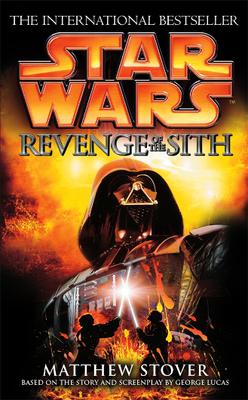
Star Wars: Revenge of the Sith is a novelization of the film of the same name, written by Matthew Stover and published on April 2, 2005, by Del Rey Books.
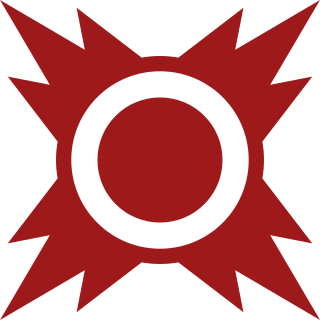
The Sith are the main antagonists of many works in the fictional universe of the Star Wars franchise. They are the antithesis and ancient enemies of the Jedi. The Sith Order is depicted as an ancient cult of warriors who draw strength from the dark side of the Force and use it to seize power by any means necessary, including terrorism and mass murder; their ultimate goals are to destroy the Jedi and rule the galaxy. The various antagonistic factions in the franchise, namely the Confederacy of Independent Systems, the First Galactic Empire, the Imperial Remnant and the First Order all originated, with the Sith. Sith, known individually as Sith Lords, are, by nature, ruthless. At any point a single individual assumes absolute authority amongst their kind and is granted the honorific Dark Lord of the Sith. Sith culture is based on perpetual treachery and betrayal. The fate of Sith Lords is, typically, to be murdered and replaced by their own apprentices. Sith teach their apprentices to revere the dark side of the Force, to give full reign to aggressive emotions such as rage and hatred, and to believe that others are expendable in the pursuit of power, it makes the Lords' demise inevitable.

Sheev Palpatine is a fictional character in the Star Wars franchise created by George Lucas. He first appears on screen in The Empire Strikes Back (1980), in which he is credited as The Emperor, and is the overarching antagonist of the three film trilogies in the Skywalker Saga, in which he is portrayed by Ian McDiarmid. The character is also known by his Sith name, Darth Sidious, which was first used in the novelization of The Phantom Menace (1999). In creating Palpatine, Lucas was inspired by real-world examples of democratic backsliding during the rise and rule of dictators such as Julius Caesar, Napoleon Bonaparte, and Adolf Hitler.

"Robot Chicken: Star Wars Episode II" is a 2008 episode of the television comedy series Robot Chicken, and the sequel to the Annie Award winning "Robot Chicken Star Wars", which aired as a one-off special during Cartoon Network's Adult Swim block on November 16, 2008. Like "Robot Chicken: Star Wars" it has been released on its own DVD, on July 21, 2009, and will not be part of a season box set. The DVD contains the original broadcast version, and the "Extended Version", which features an additional 15 minutes of footage cut from the broadcast version. It was nominated for a 2009 Primetime Emmy Award for Outstanding Animated Program.
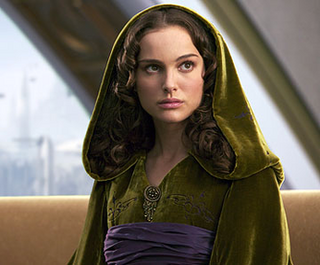
Padmé Amidala is a fictional character in the Star Wars franchise, appearing in the prequel trilogy and portrayed by Natalie Portman. First indirectly mentioned in Return of the Jedi, she is introduced in The Phantom Menace as the teenage Queen of Naboo, and after her reign, becomes a senator and an anti-war activist in the Galactic Senate. She secretly marries Anakin Skywalker, a Jedi Knight, then later dies while giving birth to twins Luke Skywalker and Leia Organa. Anakin's fear of losing Padmé serves as the catalyst in driving him to the dark side of the Force and becoming Darth Vader.

Star Wars Transformers is a Hasbro toy line started in 2006. The line features robot versions of various characters from the Star Wars franchise that transform into vehicles from the same series.
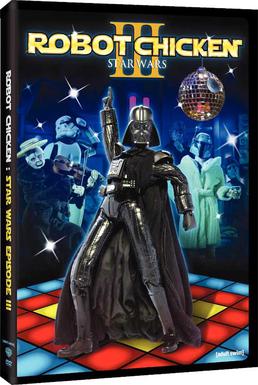
"Robot Chicken: Star Wars Episode III" is a 2010 episode special of the television comedy series Robot Chicken, and the third and final installment in the Annie Award-winning and Emmy-nominated Robot Chicken: Star Wars trilogy. It premiered on Cartoon Network's Adult Swim programming block on December 19, 2010. The special is 45 minutes long, as opposed to the usual 11-minute Robot Chicken runtime and the 21-minute runtime of the two previous Star Wars specials. It was the final Robot Chicken: Star Wars special.
References
- ↑ Vyse, Graham (11 December 2015). "Newt Gingrich Goes Full 'Star Wars' Nerd in 2007 Ken Burns Documentary". Inside Sources. Retrieved 11 March 2019.
- ↑ Pelan, Tim (30 June 2014). "Star Wars The Legacy Revealed Documentary". Cinetropolis. Retrieved 11 March 2019.
- ↑ "Parallels to history, religion, literature make Star Wars great America myth". Times Leader . 12 December 2015. Retrieved 11 March 2019.
- ↑ "Star Wars: The Legacy Revealed". Emmy Awards Database. Academy of Television Arts & Sciences. 2017. Retrieved 11 March 2019.